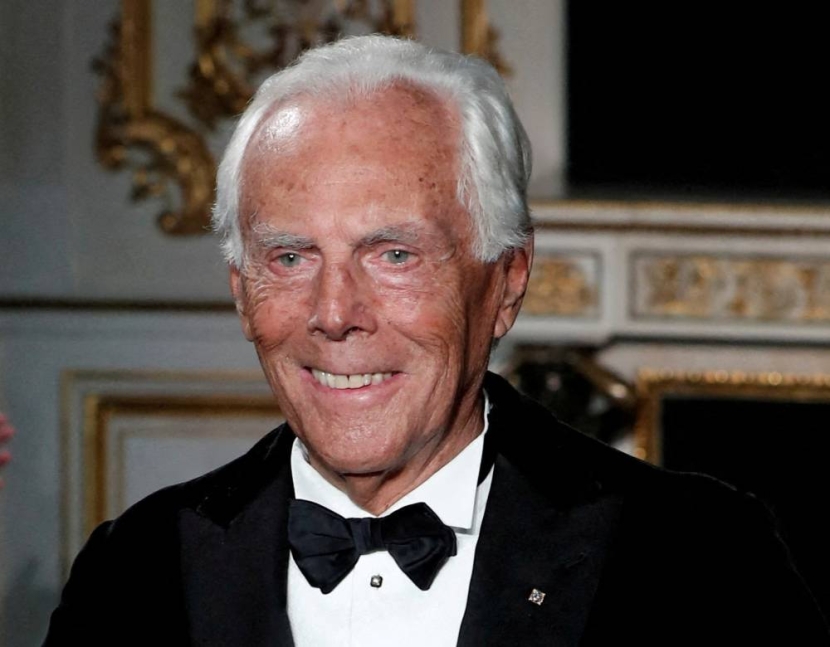
He passed away on September 5. Dubbed “King Giorgio” by the Italian media, he was considered by Culture Minister Alessandro Giuli “an icon of Italian culture,” having transformed elegance into a global language. With his concept of “simple elegance,” he built a massive fashion empire valued at billions of dollars.
The philosopher of elegance, Giorgio Armani (1934-2025), who survived a World War II mine explosion in his childhood on the street near his home, has passed away, rewriting the rules of the fashion world during a career that began late, after he reached the age of 40, compared to what he achieved during that time.
He began studying medicine at the State University of Milan in 1957, but left to join the military, which he also left to work as a photographer before working as a window designer in a Milanese department store.
The man found himself in the world of design, from shop windows to fashion and clothing, which suddenly attracted him, as he admitted in a 2015 interview: “I started in this field almost by chance, and little by little it attracted me to it, and then it completely took over.”
Armani, with the help of his architect partner Sergio Gallione, established a private company, Giorgio Armani SPA, in Milan, with $10,000 in funding from the sale of his Volkswagen, marking the birth of a fashion empire that has succeeded in carving out its own path in the world of elegance and fashion.
Armani chose to avoid the complexities that dominated 1970s fashion, preferring to make his name based on a simple trilogy: an unlined jacket, comfortable trousers, and an urban, neutral color palette. This later became a signature that accompanied his name in the world of fashion for five decades.
Unlike many others, Armani did not attend a fashion school or institute. Instead, he learned the secrets of the trade practically by listening to the dialogue between fabrics, scissors, and needles, and in showrooms. For him, elegance is a respect for form, body, and time, not an accumulation of symbols of wealth.
Armani achieved international fame in a record time of just five years, and his path to success was the film “American Gigolo” (1980), where he was tasked with designing costumes for actor Richard Gere, which opened the doors of Hollywood to him, where he designed costumes for more than 200 films.
He admitted to The Telegraph in 2013 that he had succeeded in bringing a special touch to the world of cinema: “I was one of the first designers to dress stars on and off screen, as they didn’t always have a particular style or taste that would allow them to know what to wear to special occasions… I helped them feel more confident and relaxed.”
The man was able to pave the way for Milan to compete with Paris, the capital of fashion, after expanding his empire vertically with creativity in all types of clothing: high-end (Giorgio Armani Privé), luxury (Emporio Armani), youth (Armani Exchange), sports (EA7), and even children’s clothing… and horizontally into other fields such as: perfumes, furniture, cosmetics, accessories, chocolate… and ending with luxury hotels.
Keen to ensure his brand’s presence in major markets, he moved early into Asia, opening in Japan, India, and China. His first store opened in Beijing in 1998. According to 2023 data, his empire employs more than 9,000 people worldwide, operates seven manufacturing centers, and more than 600 global stores.
Like geniuses, the man defied the norm. His fears didn’t plague him in the early days, but rather after reaching the pinnacle, when he felt the burden of success. He stated, “I could no longer take the risks I once did, and I could no longer afford not to sell. I couldn’t even afford to have low sales. My designs had become a commercial liability.”
Therefore, he maintained the company’s independence until his death, rejecting all financing offers and even refusing to list its shares on the stock exchange. This seemed to be an attempt to oppose subjecting what he had built with passion to the power of capital. He ended up with annual revenues of $2.7 billion for the group, and a fortune exceeding $12 billion.
Armani conveys in his autobiography that leadership is not linked to age at all; he started late and maintained his ardent spirit until his last days. He also asserts that the field and practice are a person’s best teachers, as long as they possess a visionary mindset. He has often repeated, “I design for real people. Clothes that don’t fit the real world are meaningless
